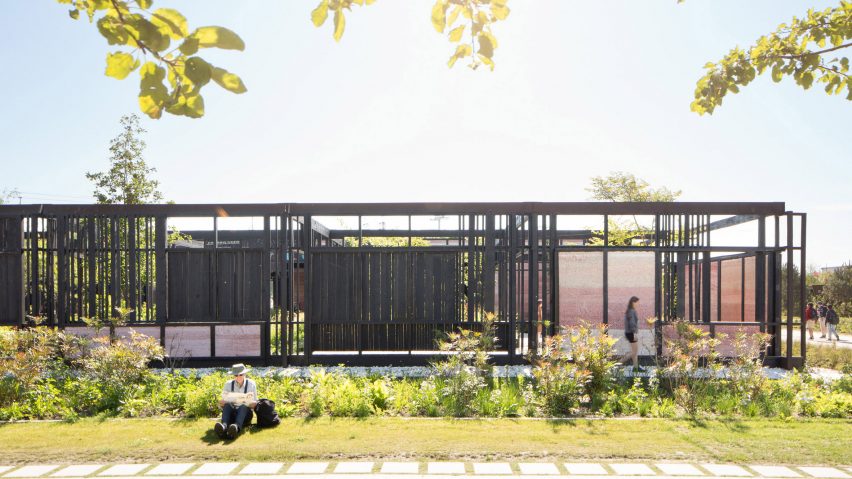Dutch studio Overtreders W has used hempcrete and reclaimed timber to create a demountable pavilion in Almere, the Netherlands, named The Voice of Urban Nature.
Enclosing a series of gardens, the pavilion sits beside the central square of Floriade – an international horticultural exhibition held every 10 years in the Netherlands.
Overtreders W designed The Voice of Urban Nature to represent the cities Almere and Amsterdam at the show.
It incorporates an exhibition by architect Kossmanndejong and series of gardens by designers Joost Emmerik and De Onkruidenier, which were intended to "give nature its own 'voice'" and spotlight how the cities are striving towards a greener future.
"The cities want to show how they work individually and collectively on the green future of Almere and Amsterdam, together with the power of nature and their citizens," Overtreders W told Dezeen.
"Almere and Amsterdam give nature its own 'voice' in their entry as an equal partner of humans."
The site of the pavilion is adjacent to the main square of Floriade 2022, which forms part of a wider masterplan for the event developed by Dutch studio MVRDV.
Overtreders W transformed its dedicated plot into an enclosed garden, which is divided into a grid of squares.
"We wanted to create an enclosed garden and therefore decided to spread out the design over the entire plot," explained the studio.
"Approaching the pavilion, it initially appears enclosed with minimal openings, but those who enter experience the light and tranquil walled garden beyond."
The Voice of Urban Nature's structure is built from a mix of pink-hued hempcrete and contrasting wood that is finished with a black coating of linseed oil and carbon.
Its framework is fully demountable and was built by construction contractor Fiction Factory using wood sourced from scrapyards and sawmills in the area.
Hempcrete, otherwise known as hemp lime, was chosen for the project as it is a biodegradable, durable and insulating material. To make it, hemp fibres are mixed with lime and water.
The hemp fibres used were also sourced locally, purchased from a farmer outside the city, and mixed with natural pink pigments from madder dye plants to give the final material a "contemporary look".
"Hemp lime is a biobased building material with a lot of potentials," said Overtreders W.
"[We] had been experimenting for some time to give the material a fresher and more contemporary look with natural pigments. This project was an opportunity to put those experiments into practice."
While constructing with hempcrete is not a new concept, the way it has been utilised at The Voice of Urban Nature is, according to the studio.
Overtreders W has applied the hemp lime within demountable wooden boxes, making easily demountable modules that can be reused. It is now developing the construction system, with the hope that The Voice of Urban Nature will become a scalable prototype.
"Overtreders W wants to further develop the demountable construction system of wooden boxes filled with lime hemp for use in temporary pavilions with a lifespan of approximately 15 years," said the studio.
"The Voice of Urban Nature then becomes a first step in a larger, scalable and more permanent development, something Overtreders W always tries with its built experiments."
Inside the pavilion are six gardens, each curated to a different theme to show the variety and potential of urban nature.
The landscaping by Joost Emmerik and De Onkruidenier strives to be organic and curved, juxtaposing the gridded form of the pavilion.
Winding between the plants is a pathway made from white oyster shells, reclaimed from local fishing industry waste.
The gardens feature QR codes leading to "audio encounters" or mini podcasts recorded by producers Jesper Buursink and Dina Kabba, which explain how people can commit to a greener future.
"From nature optimists, city tree planters, and material choreographers to a little boy who searches for herbs between paving stones: they all make the city a little greener," said Overtreders W, reflecting on the contributors to the mini podcasts.
"That enthusiasm is contagious and challenges you to contribute to or join one of the initiatives."
At the end of the festival in October, the pavilion will be demounted and transported to a new location to be rebuilt.
Overtreders W's hope is that two new pavilions will be made from its structure, one of which will be placed elsewhere in Almere and another in Amsterdam.
Founded by Reinder Bakker and Hester van Dijk, Overtreders W is a small Amsterdam-based spatial design agency that specialises in temporary structures and sustainable materials.
It recently collaborated with Dutch studio Bureau SLA to create Pretty Plastic, shingles that are made from recycled PVC windows and gutters. Other projects by the studio include the temporary RAUM pavilion in Utrecht, which employed the principles of a circular economy and a zero-waste barn and restaurant for a Dutch festival.
The photography is by Jorn van Eck.
Project credits:
Architect: Overtreders W
Client: Municipalities of Almere & Amsterdam
Exhibition design and art direction: KossmannDeJong
Landscape design: De Onkruidenier and Joost Emmerik
Construction and urban mining: Fiction Factory
Exhibition drawings: Paul Faassen
Gardener: Paul Casteleijn
Horticulturist: Blooming Business
Animation: Paul Faassen, Bas Mooij, Jonas Leopold

